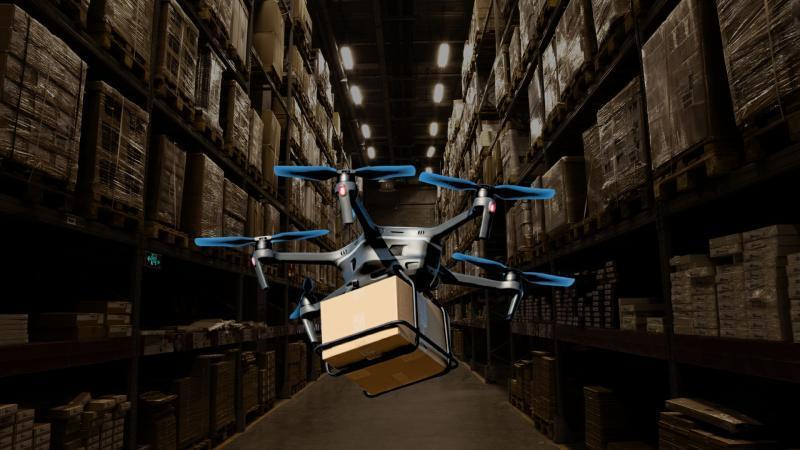
New tech optimizes drone fleets for faster, greener deliveries
Imagine your packages arriving faster with a smaller environmental footprint. The idea of drones zipping through the skies, delivering your parcels in a timely and eco-friendly manner, is no longer a distant dream. With the rise of e-commerce, the need for efficient and sustainable last-mile delivery solutions has become more pressing than ever. To tackle this challenge, researchers have developed a novel algorithm that optimizes drone delivery schedules, addressing the “Drone Warehouse Problem” and paving the way for scalable, sustainable logistics.
The Drone Warehouse Problem: A Crucial Logistics Challenge
As drone technology advances, the need to manage drone fleets efficiently has become a significant challenge. Warehouses need to coordinate the takeoff, landing, and movement of multiple drones, ensuring that packages are delivered to the right location at the right time. This is known as the Drone Warehouse Problem, and it’s a critical hurdle in the development of drone-based delivery systems.
The traditional approach to managing drone fleets involves manual scheduling, which is time-consuming, labor-intensive, and prone to errors. This not only increases costs but also slows down the delivery process, making it less effective and less sustainable. To overcome this limitation, researchers have turned to algorithmic solutions, leveraging the power of artificial intelligence and machine learning to optimize drone delivery schedules.
Novel Algorithm Tackles the Drone Warehouse Problem
A team of researchers from [Institution] has developed a novel algorithm that tackles the Drone Warehouse Problem head-on. The algorithm, which is based on a combination of machine learning and graph theory, optimizes drone delivery schedules by analyzing various factors, including:
- Drone availability and capacity
- Package volume and weight
- Weather conditions and air traffic
- Warehouse layout and drone movement constraints
- Time-sensitive delivery requirements
The algorithm uses a graph-based approach to model the drone warehouse system, representing drones, packages, and warehouses as nodes in a graph. By analyzing the graph, the algorithm determines the most efficient drone assignment, minimizing delays and reducing the number of drones required.
The results are impressive. According to the researchers, their algorithm can reduce delivery times by up to 30% compared to traditional manual scheduling methods. Moreover, the algorithm can handle large volumes of packages, making it an ideal solution for high-demand e-commerce platforms.
Impact on Last-Mile Delivery
The development of this novel algorithm has significant implications for last-mile delivery. By optimizing drone delivery schedules, warehouses can efficiently manage varied drone fleets, ensuring that packages reach customers quickly and reliably. This is particularly important for e-commerce platforms, which rely heavily on timely and efficient delivery to maintain customer satisfaction and loyalty.
The algorithm’s impact on last-mile delivery is multifaceted:
- Faster delivery times: With optimized drone delivery schedules, packages can be delivered faster, reducing the time between order placement and delivery.
- Increased reliability: The algorithm ensures that drones are assigned to the right packages, minimizing the risk of delays and lost packages.
- Reduced costs: By optimizing drone usage, warehouses can reduce fuel consumption, maintenance costs, and labor costs, making last-mile delivery more sustainable and cost-effective.
- Enhanced customer experience: With faster and more reliable delivery, customers can expect a better overall experience, driving loyalty and retention.
The Future of Drone-Based Delivery
The novel algorithm developed by the researchers is a significant step forward in the development of drone-based delivery systems. As the demand for e-commerce continues to grow, the need for efficient and sustainable last-mile delivery solutions will become increasingly important.
The algorithm’s potential applications are vast and varied:
- E-commerce platforms: Online retailers can use the algorithm to optimize their drone delivery schedules, ensuring that packages are delivered quickly and reliably.
- Logistics companies: Logistics providers can leverage the algorithm to manage large-scale drone fleets, streamlining their operations and reducing costs.
- Government agencies: Governments can use the algorithm to optimize their disaster response and emergency services, ensuring that critical supplies are delivered quickly and efficiently.
In conclusion, the development of a novel algorithm that optimizes drone delivery schedules is a significant breakthrough in the field of logistics. By addressing the Drone Warehouse Problem, researchers have paved the way for scalable, sustainable last-mile delivery solutions that can revolutionize the way we think about package delivery.
News Source:
https://researchmatters.in/news/novel-algorithm-tackles-drone-warehouse-problem-faster-deliveries






